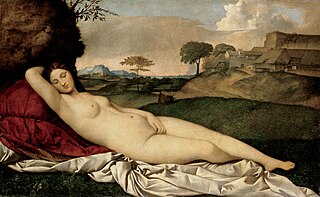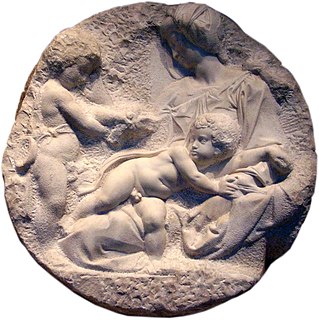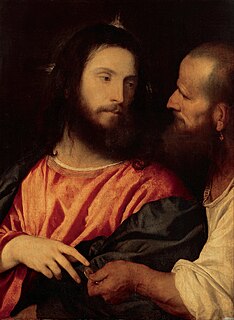
Mannerism, also known as Late Renaissance, is a style in European art that emerged in the later years of the Italian High Renaissance around 1520, spreading by about 1530 and lasting until about the end of the 16th century in Italy, when the Baroque style largely replaced it. Northern Mannerism continued into the early 17th century.

Michelangelo di Lodovico Buonarroti Simoni, known simply as Michelangelo, was an Italian sculptor, painter, architect and poet of the High Renaissance born in the Republic of Florence, who exerted an unparalleled influence on the development of Western art. His artistic versatility was of such a high order that he is often considered a contender for the title of the archetypal Renaissance man, along with his rival, the fellow Florentine, Leonardo da Vinci. Several scholars have described Michelangelo as the greatest artist of his age and even as the greatest artist of all time.

David is a masterpiece of Renaissance sculpture, created in marble between 1501 and 1504 by the Italian artist Michelangelo. David is a 5.17-metre (17.0 ft) marble statue of the Biblical figure David, a favoured subject in the art of Florence.

Tiziano Vecelli or Vecellio, known in English as Titian, was a Venetian painter during the Renaissance, considered the most important member of the 16th-century Venetian school. He was born in Pieve di Cadore, near Belluno. During his lifetime he was often called da Cadore, 'from Cadore', taken from his native region.

The Venus of Urbino is an oil painting by the Italian painter Titian, which seems to have been begun in 1532 or 1534, and was perhaps completed in 1534, but not sold until 1538. It depicts a nude young woman, traditionally identified with the goddess Venus, reclining on a couch or bed in the sumptuous surroundings of a Renaissance palace. It is now in the Galleria degli Uffizi in Florence.

Bacchus (1496–1497) is a marble sculpture by the Italian High Renaissance sculptor, painter, architect and poet Michelangelo. The statue is somewhat over life-size and depicts Bacchus, the Roman god of wine, in a reeling pose suggestive of drunkenness. Commissioned by Raffaele Riario, a high-ranking Cardinal and collector of antique sculpture, it was rejected by him and was bought instead by Jacopo Galli, Riario’s banker and a friend to Michelangelo. Together with the Pietà the Bacchus is one of only two surviving sculptures from the artist's first period in Rome.

The Deposition is a marble sculpture by the Italian High Renaissance master Michelangelo. The sculpture, on which Michelangelo worked between 1547 and 1555, depicts four figures: the dead body of Jesus Christ, newly taken down from the Cross, Nicodemus, Mary Magdalene and the Virgin Mary. The sculpture is housed in the Museo dell'Opera del Duomo in Florence and is therefore also known as the Florentine Pietà.

The Sleeping Venus, also known as the Dresden Venus, is a painting traditionally attributed to the Italian Renaissance painter Giorgione, although it has long been usually thought that Titian completed it after Giorgione's death in 1510. The landscape and sky are generally accepted to be mainly by him. In the 21st century, much scholarly opinion has shifted further, to see the nude figure of Venus as also painted by Titian, leaving Giorgione's contribution uncertain. It is in the Gemäldegalerie, Dresden. After World War II, the painting was briefly in possession of the Soviet Union.
Events from the year 1504 in art.

Non finito is a sculpting technique meaning that the work is unfinished. Italian in etymology, it literally means "not finished". Non finito sculptures appear unfinished because the artist only sculpts part of the block, the figure sometimes appearing to be stuck within the block of material. It was pioneered by Donatello during the Renaissance and was also used by Michelangelo among others.

Italian Renaissance painting is the painting of the period beginning in the late 13th century and flourishing from the early 15th to late 16th centuries, occurring in the Italian peninsula, which was at that time divided into many political states, some independent but others controlled by external powers. The painters of Renaissance Italy, although often attached to particular courts and with loyalties to particular towns, nonetheless wandered the length and breadth of Italy, often occupying a diplomatic status and disseminating artistic and philosophical ideas.

In classical mythology, Cupid is the god of desire, erotic love, attraction and affection. He is often portrayed as the son of the love goddess Venus and the god of war Mars. He is also known in Latin as Amor ("Love"). His Greek counterpart is Eros. Although Eros is generally portrayed as a slender winged youth in Classical Greek art, during the Hellenistic period, he was increasingly portrayed as a chubby boy. During this time, his iconography acquired the bow and arrow that represent his source of power: a person, or even a deity, who is shot by Cupid's arrow is filled with uncontrollable desire. In myths, Cupid is a minor character who serves mostly to set the plot in motion. He is a main character only in the tale of Cupid and Psyche, when wounded by his own weapons, he experiences the ordeal of love. Although other extended stories are not told about him, his tradition is rich in poetic themes and visual scenarios, such as "Love conquers all" and the retaliatory punishment or torture of Cupid. His powers are similar, though not identical, to Kamadeva the Hindu god of human love.

Danaë is a series of at least six versions of the same composition by Italian painter Titian and his workshop made between about 1544 and the 1560s. The scene is based on the mythological princess Danaë, as -very briefly- recounted by the Roman poet Ovid, and at greater length by Boccaccio. She was isolated in a bronze tower following a prophecy that her firstborn would eventually kill her father. Although aware of the consequences, Danaë was seduced and became pregnant by Zeus, who, inflamed by lust, descended from Mount Olympus to seduce her in the form of a shower of gold.

The Taddei Tondo or The Virgin and Child with the Infant St John is a marble relief tondo of the Madonna and Child and the infant Saint John the Baptist, by the Italian Renaissance artist Michelangelo Buonarroti. It is in the permanent collection of the Royal Academy of Arts in London, it is the only marble sculpture by Michelangelo in Great Britain. A "perfect demonstration" of his carving technique, the work delivers a "powerful emotional and narrative punch".

The Penitent Magdalene is a painting of saint Mary Magdalene by Titian dating to around 1531, signed 'TITIANUS' on the ointment jar to the left. It is now in the Sala di Apollo of the Palazzo Pitti in Florence, Italy.

The Tribute Money is a panel painting in oils of 1516 by the Italian late Renaissance artist Titian, now in the Gemäldegalerie Alte Meister in Dresden, Germany. It depicts Christ and a Pharisee at the moment in the Gospels when Christ is shown a coin and says "Render unto Caesar the things that are Caesar's, and unto God the things that are God's". It is signed "Ticianus F.[ecit]", painted on the trim of the left side of the Pharisee's collar.

The Medici Madonna is a marble sculpture carved by Italian Renaissance master Michelangelo Buonarroti that measures about 88.98 inches in height. Dating from 1521–1534 the sculpture is a piece of the altar decoration of the Sagrestia Nuova in the Basilica of San Lorenzo, Florence.

Girl in a Fur is a 1536–1538 painting by Titian, now in the Kunsthistorisches Museum in Vienna. He painted the same model in La Bella and Venus of Urbino.

The Altoviti are a prominent noble family of Florence.

The Pardo Venus is a painting by the Venetian artist Titian, completed in 1551 and now in the Louvre Museum. It is also known as Jupiter and Antiope, since it seems to show the story of Jupiter and Antiope from Book VI of the Metamorphoses. It is Titian's largest mythological painting, and was the first major mythological painting produced by the artist for Philip II of Spain. It was long kept in the Royal Palace of El Pardo near Madrid, hence its usual name; whether Venus is actually represented is uncertain. It later belonged to the English and French royal collections.



















